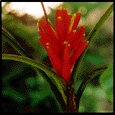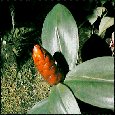



Heliconeaceae Strelitziaceae Musaceae Costaceae




Lowiaceae
Marantaceae
Zingiberaceae
Cannaceae
BOTANIC DEFINITIONS
Division: MAGNOLIOPHYTA (Angiospermae)The entire range of 250.000 worldwide flowering plants
Class: LILIOPSIDA (Monocotyledonae)
Plants with
a single cotyledon in the seed.
The lilly
is
the type genus for which the class is named
Subclass:LILIIDAE
Herbaceous or rarely arborescent plants. Vessels mostly in the roots only, rarely in the stems and leaves. Stomata mostly without subsidiary cells, rarely with 2 (some representatives of the order LILIIDAE) or 2 or more subsidiary cells (Zingiberales). Gynoecium almost always coenocarpous (mostly syncarpous), very rarely almost apocarpous. Pollen grains usually 2 -celled mostly monocolpate. Seeds with or without endosperm.
Five orders:
1. Triuridales, one family Triuridaceae
2. Liliales,
shares a common origin with the Alismales. Families number 18, including
Liliaceae (lily)
Amaryllidaceae (amaryllis),
Dioscoreaceae (yam), Agavaceae (agaves) and 4 Asparagaceae (aspargus)
3. Iridales, probably derived from the family Liliaceae. Four families, including Iridaceae (iris)
4. Orchidales, probably derived from the Liliales. One family, Orchidaceae (orchid)
5. Zingiberales (see the families above)
Order: ZINGIBERALES
Rhizomatous herbs, rarely arborescent. Leaves mostly with an open sheath, sometimes ligulate. Leaf blades entire with many lateral veins diverging from a common midrib region. One-half of the leaf blade completely rolled around the other in the bud. Inflorescence terminal or lateral, commonly racemose with conspicuos bracts; in the axil of each bract a monochasial cyme, sometimes reduced to a single flower. Flowers zygomorphic. Perianth consisting of separate calyx and corolla. Perfect stamens rarely 6, usually 5 or 1. Sterile stamens 1 to 5, often represented by staminodes of great diversity. Ovary inferior, usually trilocular, with one to many ovules in each locule. Seeds with abundant endosperm often with an aril.
Eight families, 89 genera, and about 1800 species distributed mostly in the tropics.
| MAIN PAGE | INFO SOURCES | LINKS | MY PROFILE | GEOCITIES MENU |